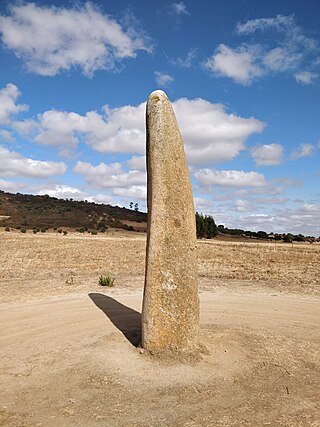
Évora District is located in Alentejo, in southern Portugal. The district capital is the city of Évora. It borders Spain.

Reguengos de Monsaraz is a municipality in Évora District in Portugal. The population in 2011 was 10,828, in an area of 464.00 km2. The City of Reguengos de Monsaraz proper has a population of 7,308.

Monsaraz is a civil parish (freguesia) of the municipality of Reguengos de Monsaraz, on the right margin of the Guadiana River in the Portuguese Alentejo region, near its border with Spain. The population in 2011 was 782, in an area of 88.29 km2.

The arrondissement of La Tour-du-Pin is an arrondissement of France in the Isère department in the Auvergne-Rhône-Alpes region. It has 136 communes. Its population is 302,380 (2016), and its area is 1,543.1 km2 (595.8 sq mi).

Freeburg Township is located in St. Clair County, Illinois. As of the 2010 census, its population was 5,109 and it contained 2,118 housing units.

Alto Alentejo was a Portuguese province. It was abolished with the Constitution of 1976.
Alberto de Morés Monsaraz was a Portuguese politician and poet. He was one of the central figures in the Integralismo Lusitano that dominated the far-right of Portuguese politics during the early years of the twentieth century.

Paramirim is a municipality in the state of Bahia in the North-East region of Brazil.
Logradouro is a municipality in the state of Paraíba in the Northeast Region of Brazil.
Senador La Rocque is a municipality in the state of Maranhão in the Northeast region of Brazil.

Current, Piaui is a municipality in the state of Piauí in the Northeast region of Brazil.

The Lisbon Naval Base, is the main installation and operational base of the Portuguese Navy. Located at the former Royal Estate of Alfeite on the south bank of the Tagus river's estuary, near the city of Almada, the installation is sometimes referred to as the Alfeite Naval Base.

The Castle of Redondo is a medieval castle located in the civil parish of Redondo, in the municipality of Redondo, Portuguese Évora.
The Castle of Degebe is a medieval castle located in the civil parish of Reguengos de Monsaraz, in the municipality of Reguengos de Monsaraz, Portuguese district of Évora.

The Castle of Esporão is a medieval castle in the civil parish of Reguengos de Monsaraz, municipality of Reguengos de Monsaraz, district of Évora.
The Castle of Vidigueiras is a signeurial residential estate in the civil parish of Reguengos de Monsaraz in the municipality of Reguengos de Monsaraz in the Portuguese sub-region of Baixo Alentejo. It is the only residential project completed by landscape architect Francisco Caldeira Cabral.
Watkins is an unincorporated community in Miller County, in the U.S. state of Missouri. The community lies on a ridge between Barren and Brushy Forks on Missouri Route KK, approximately five miles northwest of Iberia.

The Xerez Cromlech, also known as the Xarez Cromlech, is a megalithic complex that is believed to date back to the 4th or 5th millennia BCE. It is situated near the town of Monsaraz in the Évora district of the Alentejo region of Portugal, close to the Spanish border. The present site of the cromlech is not its original location. Due to the construction of the Alqueva Dam for hydroelectric purposes, which led to the flooding of the original site from 2002, it was transferred from an area that is now under water to its present site close to the Orada Convent. This was the only monument to be moved, with the dam leading to the disappearance of prehistoric engravings and the Roman Castelo da Lousa.

The Menhir of Outeiro, also known as the Penedo Comprido, is a megalith located midway between the villages of Outeiro and Barrada near the municipality of Reguengos de Monsaraz, in the district of Évora, in the Alentejo region of Portugal. It is a few kilometers from the Portuguese-Spanish-border. The stone was discovered on its side in 1969 by Henrique Leonor Pina and José Pires Gonçalves and, on the initiative of Gonçalves, was raised again around 1970. The menhir was classified as a Portuguese National Monument in 1971.

The Menhir of Bulhoa, also known as the Menhir of Abelhoa, is a granite megalithic standing stone, located near the parish of Monsaraz, in the municipality of the Reguengos de Monsaraz, in the Évora district of the Alentejo region of Portugal. It was classified as a National Monument by the Government of Portugal in 1971.
This page is based on this
Wikipedia article Text is available under the
CC BY-SA 4.0 license; additional terms may apply.
Images, videos and audio are available under their respective licenses.
















